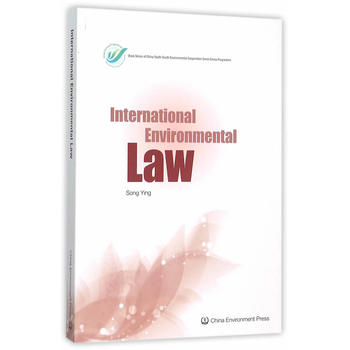简介
宋英编*的《国际环境法(英文版)》为环境保护部宣传教育中心组织相关专家和学者首创的国际环境合作培训教材,为中国-南南环境保护合作项目中的重要一环,面向国际援助国家,对非洲国家等进行援助培训的教材。本书为主要针对国际环境法方面进行了全面、详细的阐述。
目录
1 Introduction
1.1 The Environment - Concept and Issues
1.2 Environmental Challenges and Responses
1.3 Environment and International Legal Order
1.4 China & International Environmental Law in General
1.5 Conclusion
2 Origin and Evolution of International Environmental Law
2.1 Introduction
2.2 Before the 1972 Stockholm Conference
2.3 From Stockholm to Rio: 1972--1992
2.4 From Rio to Rio+20
2.5 Conclusion
3 Institutions and Governance
3.1 Introduction
3.2 States
3.3 International Institutions
3.4 Non-State Actors
3.5 Conclusion
4 General Principles and Rules
4.1 Introduction
4.2 Sovereignty over Natural Resources and the Responsibility
Not to Cause Damage to the Environment of other States or to Areas beyond National Jurisdiction
4.3 Principle of Preventive Action
4.4 Precautionary Principle
4.5 Polluter pays Principle
4.6 Principle of Common but Differentiated Responsibilities
4.7 International Cooperation
4.8 Sustainable Development
4.9 Conclusion
5 Implementation of the General Principles and Rules
5.1 Introduction
5.2 Regulatory Measures
5.3 Economic Instruments
5.4 Integrated Environmental Management
5.5 Environmental Impact Assessment and Risk Assessment
5.6 Environmental Information
5.7 Conclusion
6 Compliance: Enforcement and Conflict Resolution
6.1 Introduction
6.2 National Compliance of International Environmental Law
6.3 International Compliance Mechanisms
6.4 International Environmental Conflict Resolution
6.5 Conclusion
7 Atmosphere
7.1 Introduction
7.2 Transboundary Air Pollution
7.3 Ozone Depletion
7.4 Climate Change
7.5 Outer Space
7.6 China and Atmosphere
7.7 Conclusion
8 Oceans and Seas
8.1 Introduction
8.2 Combating Different Sources of Marine Pollution
8.3 Regional Seas Programmes
8.4 China and Oceans and Seas
8.5 Conclusion
9 Freshwater Resources
9.1 Introduction
9.2 Global Responses
9.3 Regional Responses
9.4 China and Freshwater Resources
9.5 Conclusion
10 Biological Diversity
10.1 Introduction
10.2 International Legal Responses .
10.3 Biotechnology & Biosafety
10.4 Access and Benefit Sharing
10.5 Conservation of Marine Living Resources and Marine Biodiversity
10.6 China and Biological Diversity
10.7 Conclusion
11 Land Resources
11.1 Introduction
11.2 International Legal and Policy Responses
11.3 Combating Desertification
11.4 Wetlands
11.5 World Heritages
11.6 Polar Regions
11.7 China and Land Resources
11.8 Conclusion
12 Hazardous Substances and Activities
12.1 Introduction
12.2 Chemicals, Pesticides and other Dangerous Substances
12.3 Persistent Organic Pollutants
12.4 Hazardous Wastes
12.5 Mercury
12.6 Radioactive Substances & Activities
12.7 Accident Prevention, Preparedness and Response
12.8 China and Hazardous Substances and Activities
12.9 Conclusion
13 Economic Activities and Environment
13.1 Introduction
13.2 Poverty Eradication and Environment
13.3 International Trade and Environment
13.4 Green Economy
13.5 Chinese Perspectives
13.6 Conclusion
14 Human Rights and Environment
14.1 Introduction
14.2 The Linkage between Human Rights and Environment: Global Approaches and Efforts
14.3 Regional and National Approaches and Efforts
14.4 China: Human Rights and Environment
14.5 Conclusion
15 Armed Conflict & Environment
15.1 Introduction
15.2 International Humanitarian Law
15.3 International Criminal Law
15.4 Human Rights Law
15.5 International Environmental Law
15.6 Conclusion
Select Bibliography
Abbreviations and Acronyms
About the Author
Acknowledgements
1.1 The Environment - Concept and Issues
1.2 Environmental Challenges and Responses
1.3 Environment and International Legal Order
1.4 China & International Environmental Law in General
1.5 Conclusion
2 Origin and Evolution of International Environmental Law
2.1 Introduction
2.2 Before the 1972 Stockholm Conference
2.3 From Stockholm to Rio: 1972--1992
2.4 From Rio to Rio+20
2.5 Conclusion
3 Institutions and Governance
3.1 Introduction
3.2 States
3.3 International Institutions
3.4 Non-State Actors
3.5 Conclusion
4 General Principles and Rules
4.1 Introduction
4.2 Sovereignty over Natural Resources and the Responsibility
Not to Cause Damage to the Environment of other States or to Areas beyond National Jurisdiction
4.3 Principle of Preventive Action
4.4 Precautionary Principle
4.5 Polluter pays Principle
4.6 Principle of Common but Differentiated Responsibilities
4.7 International Cooperation
4.8 Sustainable Development
4.9 Conclusion
5 Implementation of the General Principles and Rules
5.1 Introduction
5.2 Regulatory Measures
5.3 Economic Instruments
5.4 Integrated Environmental Management
5.5 Environmental Impact Assessment and Risk Assessment
5.6 Environmental Information
5.7 Conclusion
6 Compliance: Enforcement and Conflict Resolution
6.1 Introduction
6.2 National Compliance of International Environmental Law
6.3 International Compliance Mechanisms
6.4 International Environmental Conflict Resolution
6.5 Conclusion
7 Atmosphere
7.1 Introduction
7.2 Transboundary Air Pollution
7.3 Ozone Depletion
7.4 Climate Change
7.5 Outer Space
7.6 China and Atmosphere
7.7 Conclusion
8 Oceans and Seas
8.1 Introduction
8.2 Combating Different Sources of Marine Pollution
8.3 Regional Seas Programmes
8.4 China and Oceans and Seas
8.5 Conclusion
9 Freshwater Resources
9.1 Introduction
9.2 Global Responses
9.3 Regional Responses
9.4 China and Freshwater Resources
9.5 Conclusion
10 Biological Diversity
10.1 Introduction
10.2 International Legal Responses .
10.3 Biotechnology & Biosafety
10.4 Access and Benefit Sharing
10.5 Conservation of Marine Living Resources and Marine Biodiversity
10.6 China and Biological Diversity
10.7 Conclusion
11 Land Resources
11.1 Introduction
11.2 International Legal and Policy Responses
11.3 Combating Desertification
11.4 Wetlands
11.5 World Heritages
11.6 Polar Regions
11.7 China and Land Resources
11.8 Conclusion
12 Hazardous Substances and Activities
12.1 Introduction
12.2 Chemicals, Pesticides and other Dangerous Substances
12.3 Persistent Organic Pollutants
12.4 Hazardous Wastes
12.5 Mercury
12.6 Radioactive Substances & Activities
12.7 Accident Prevention, Preparedness and Response
12.8 China and Hazardous Substances and Activities
12.9 Conclusion
13 Economic Activities and Environment
13.1 Introduction
13.2 Poverty Eradication and Environment
13.3 International Trade and Environment
13.4 Green Economy
13.5 Chinese Perspectives
13.6 Conclusion
14 Human Rights and Environment
14.1 Introduction
14.2 The Linkage between Human Rights and Environment: Global Approaches and Efforts
14.3 Regional and National Approaches and Efforts
14.4 China: Human Rights and Environment
14.5 Conclusion
15 Armed Conflict & Environment
15.1 Introduction
15.2 International Humanitarian Law
15.3 International Criminal Law
15.4 Human Rights Law
15.5 International Environmental Law
15.6 Conclusion
Select Bibliography
Abbreviations and Acronyms
About the Author
Acknowledgements
International Environmental Law
- 名称
- 类型
- 大小
光盘服务联系方式: 020-38250260 客服QQ:4006604884
云图客服:
用户发送的提问,这种方式就需要有位在线客服来回答用户的问题,这种 就属于对话式的,问题是这种提问是否需要用户登录才能提问
Video Player
×
Audio Player
×
pdf Player
×



